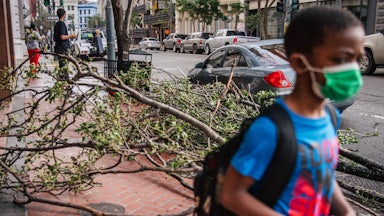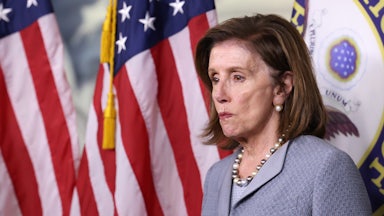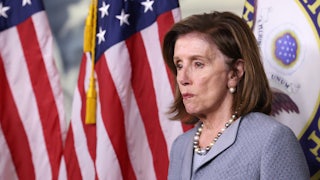Jay O’Neal, an eighth-grade social studies teacher in West Virginia, is an unusually jovial man, someone who punctuates every conversation with hearty laughter. But when he talks about the school year, his tone turns somber. “So far, this year has been worse than last year, which I never thought was going to be possible,” he told me. O’Neal has been teaching in person for the better part of the past year, and he believes pandemic-era schooling has reached a new low.
In the midst of the fastest-accelerating surge yet, millions of students in the United States went back to school with few precautions or none at all. The result was painfully predictable. Nearly one million—925,000—kids tested positive for Covid-19 in a single four-week stretch, according to data published last week. A month into their school year, there have been as many Covid cases among Texas students as in all of last year. Most Covid outbreaks in Georgia are now in schools, public health officials say. Yet Florida has a new rule: If a student is exposed to Covid-19, parents decide whether they quarantine.
While severe health effects for kids who contract Covid-19 remain rare, every case is an opportunity for a rare outcome—and the more contagious delta variant offers many more opportunities. Schools scrambling to respond to outbreaks have had to improvise sometimes chaotic solutions. And the unchecked transmission is already dramatically affecting kids’ education this year. Covid-19 has also created a “dire” shortage of teachers and school staff in the U.S.
“The thing that is frustrating me and so many teachers this year,” O’Neal said, “is why are we not taking the mitigation strategies that we at least took last year?” His school has a mask mandate, but that’s about it. There’s no screening testing, no distancing, no vaccination requirements, no ventilation improvements. Last year, at least, the school offered virtual instruction, so classes were about half their normal size, but that’s no longer an option. “We’re basically pretending like everything is normal,” he said—yet in fact, this may be the worst part of the pandemic for kids.
Since O’Neal’s school started two months ago, more than 50 students have already tested positive, with dozens of others quarantining after close contact; there are only about 480 kids in the school. O’Neal himself just came back last week after he contracted the virus, despite being fully vaccinated and wearing a mask religiously. Some of his students have had to quarantine multiple times, and he’s only seen them for two or three out of the past eight weeks. “You’re constantly trying to catch people up,” he said. Two out of eight teachers for eighth-grade classes are currently quarantining or sick with Covid-19, but there are no substitutes, so they’ve had to scramble to move students into different classrooms—creating further disruptions and infection risks.
The benefits of education are undeniable, and it’s clear that many—though not all—children do better when they learn in person. But in order to do that safely, we needed to get control of the pandemic, and we never did.
“We knew it was coming,” Dr. Cecília Tomori, director of global public health and community health at the Johns Hopkins School of Nursing, told me. “We talked about it, we warned about it. And we just basically sent kids back without first ensuring that all the safety measures were in place.” She calls it a “DIY pandemic,” where families have been given little guidance and few options on keeping their kids, and communities, safe. “We are asking individual families to figure out how to prevent transmission from their children.”
Many schools also neglected to take even basic precautions, with states like Florida, Iowa, and Texas banning mask mandates. Two reports released on Friday by the U.S. Centers for Disease Control and Prevention found that masks greatly reduced cases in and out of schools. Schools were more than three times more likely to have outbreaks if they didn’t have mask mandates, one study found. Another study, conducted at the beginning of this school year, found that counties with school mask requirements had significantly lower spread than those without them—even as the more contagious delta variant circulated.
“The most striking thing for us was to see how stark the differences in rates were before and after the start of school,” Dr. Sharyn Parks, an author on that study and a member of the CDC Covid-19 Response Team, told me. “We were excited to put these results out there, to get some really black-and-white evidence of how masking in schools can really help control the spread.”
But even in schools with mask policies, there is still some spread. Families—especially families of color, according to some surveys—were still uncertain about sending kids back to school in June, before the delta variant surge, and they lamented the lack of virtual options. Other precautions like regular screening testing, improved ventilation, and contact tracing have also been implemented unevenly.
Dr. Abigail Cartus, an epidemiologist at the Brown University School of Public Health, watched in frustration as a narrative that kids didn’t suffer from or spread Covid-19 took root, despite plenty of evidence to the contrary. “Maybe we didn’t record many cases of Covid in children because schools were closed,” she said. “There was this persistent narrative that schools are completely safe and that kids aren’t really that severely affected by Covid.… I think what we’ve learned over the past year is that both of those claims were bullshit. Obviously wrong.”
Rather than changing school policies, particularly as other countries began reporting younger and younger patients becoming extremely sick with the delta variant, most schools in the U.S. pushed forward with plans for full reopening in the fall. Cartus remembers looking at data from U.K. schools in May and thinking, “Oh my God, we’re pushing these kids into the path of an oncoming train because we won’t admit—using ‘we’ in a very general sense—that we got it kind of wrong last year.”
What she means, she said, is that last year could have been a learning experience in which we realized how much illness can disrupt our lives and our educations, and vowed to make permanent changes to create safer environments. Instead, Cartus said, “everyone’s priority is just getting things back to exactly how they were on March 1, 2020.”
Policies still haven’t changed much, despite the high rates of infection among kids. “The entire terms of the conversations have shifted, so we now have to defend the idea that it’s actually not really acceptable to have mass infection of children,” Tomori said. “This is not supposed to be happening.” She worries that we are now in even worse shape for what’s coming next—whether it’s another wave of Covid-19 or the next pandemic. “Why are we doing it this way, and why are we not imagining a different possibility?”
No one’s advocating another year of remote learning. But there are a number of things we could be doing to make schools safer and respond to local outbreaks. One of the biggest lessons from last year—one that continues to be overlooked—is that schools are only as safe as the communities they’re in. Stopping the spread of the virus within communities is one of the most effective ways to ensure safety in school. Yet, Tomori said, “we started back in the middle of a giant surge.”
In other countries with more effective pandemic responses, policies are pegged to community spread. In times of high transmission, schools go virtual, states and counties impose mask mandates, public gatherings are limited. “That makes it easier to get a handle on what’s going on in a school, because you have fewer people who would potentially be bringing the virus in,” Tomori said.
We could be investing in better safety infrastructure, too. Last fall, O’Neal remembers wondering, “Why are they not talking about ventilation, why are we not getting air purifiers or at least better fans or something in rooms?” Many classrooms still don’t have them. “Now it’s a year later and, at least in my school, we’ve still seen no difference,” he said. Schools should also test for Covid regularly and support those who need to quarantine or isolate.
O’Neal also wonders why, almost two years in, teachers and school staff aren’t better supported in a job we’ve all agreed is essential. “Teacher morale is at an all-time low. Everybody I’m talking to is looking for a different job,” he said. He loves his job. He gets to teach children about the world; he gets to expand their horizons and change their minds. But he’s worried that without significant changes to how education happens during this pandemic, teachers will burn out and leave the profession—and new teachers won’t want to enter it at all. “This job is already low-paid, not always appreciated like it should be,” he said. “But this year it’s just the added stress of all this—it’s very frustrating.”
There is always time to make changes and save more lives. The deadly surge from the delta variant now appears to be waning. If that trend holds, it offers us an opportunity to prepare for the next surge, the next variant, or the next entirely different pandemic. That means implementing policies based on community transmission and vaccination rates, and understanding how to make learning flexible yet effective. It means supporting those who work in schools and care centers, helping parents stretched to the breaking point, and protecting kids from a virus that is only getting deadlier. It means putting into place everything we have learned in the past few months. Our future depends on it.








